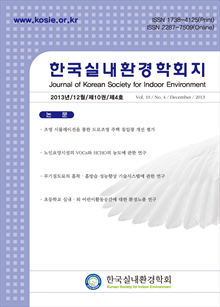간행물
한국실내환경학회지 KCI 등재후보 Journal of Korean Society for Indoor Environment

- 발행기관 한국실내환경학회
- 자료유형 학술지
- 간기 계간
- ISSN 1738-4125 (Print)2287-7509 (Online)
- 수록기간 2004 ~ 2013
- 주제분류 공학 > 환경공학 공학 분류의 다른 간행물
- 십진분류KDC 547DDC 697
권호리스트/논문검색
Vol. 8 No. 1 (2011년 3월) 5건
1.
2011.03
구독 인증기관 무료, 개인회원 유료
A system has been developed to reduce fluctuation of the indoor temperature in a radiant floor heating system. The system we developed and implemented is called BoilerMan. With the BoilerMan system the hot water circulation pump is controlled by computer software which implements a unique strategy. To minimize the system development time a user-friendly development environment was used. This development environment was useful in the implementation and testing of the efficiency of our strategy. The environment also serves as an easy means for system maintenance. The BoilerMan went through a few test runs against a real apartment house and the result showed significant reductions in the initial temperature overshoots against the target values. It also reduced the operatingtime of the hot water circulation pump. Such positive results were possible due to our unique strategy that exploits heating efficiency information collected from the past run of the very same system. Since the strategy was implemented with embedded software, it makes the BoilerMan flexible, too.
4,000원
2.
2011.03
구독 인증기관 무료, 개인회원 유료
The objective of this study is to assess a level of microbial contamination in the KTX. Investigation sites in the KTX were cabin, gateway, toilet and passenger seat. It was found that the mean concentrations of airborne bacteria and fungi were 157 CFU/m3 and 84 CFU/m3 , respectively, in all of the investigation sites of the KTX. They did not exceed the domestic standard (800 CFU/m3 ) for airborne bacteria and the guideline (150 CFU/m3 ) for airborne fungi recommended by WHO. Mean levels of bacteria and fungi distributed in passenger seat were 2.6×105 cfu/m3 and 3.7×104 cfu/m3 , respectively. The predominant genera identified in the KTX were Bacillus, Corynebacterium, Staphylococcus and Micrococcus for bacteria and Aspergillus, Cladosporium and Penicillium for fungi, respectively. Based on identification result, the profiles of airborne bacteria and fungi in the KTX was wholly similar to those of bacteria and fungi distributed in the passenger seat.
4,000원
3.
2011.03
구독 인증기관 무료, 개인회원 유료
This study assessed the health risk of trace elements in indoor children-facilities by multi-pathway measurements (Air, Dust, Wipe, Hand washing). The samples of indoor place were collected at various children's facilities (40 day-care houses, 42 child-care centers, 44 kindergartens, and 42 indoor playgrounds) in summer (Jul~Sep, 2007) and winter (Jan~Feb, 2008) periods, and analyzed by ICP-MS. The lifetime Excess Cancer Risks (ECRs) were estimated for carcinogen trace elements such as As, Cd, Cr and Ni. For carcinogens, the Excess Cancer Risk (ECR) was calculated by considering the process of deciding Cancer Potency Factor (CPF) and Age Dependent Adjust Factor (ADAF) of the data of adults. Both Hazard Quotients (HQs) and Hazard Index (HI) were estimated for the non-carcinogens and children sensitivity trace elements like Cd, Cu, and Cr. The average ECRs for young children were 1×10-10~1×10-6 (50%th percentile) level in all facilities. Non-carcinogens and Children's sensitivity materials did not exceed 1.0 (HQs, HI) for all subjects in all facilities. For trace elements their detection rates through multi-pathways were not high and their risk based on health risk assessment was also observed to be acceptable. In addition, through education on the risk of multi-pathway exposure of trace elements for managers of facilities as well as for users the risk control of exposure of children.
5,400원
4.
2011.03
구독 인증기관 무료, 개인회원 유료
In this study, an enthalpy exchanger was coated by silver nano particles via spark discharge method and its antimicrobial and heat exchange efficiencies were evaluated. A method utilizing thermophoretic force was used to improve coating efficiency. Four spark discharge systems were parallel connected and generated silver nano aerosol particles (number concentration of 1.65×108 particles/cc, mode diameter of 31 nm). The coating efficiency was evaluated according to various face velocities (V=0.25~1 m/s) and temperature gradients ((Thot-Tcold)/Thot=0~0.09). The maximum coating efficiency was 90.8 % when the face velocity was 0.25 m/s and the temperature gradient was 0.09 (Thot=30℃, Tcold=2℃). Silver nano particles were coated onto the enthalpy exchange element and two different coating amounts of silver nano particles (0.11 ㎍/cm3 , 0.22 ㎍/cm3 ) were tested. For evaluation of antimicrobial efficiency, the suspension test method with E. coli was used. After the suspension test method, CFU(colony forming unit)s of each test sample were counted and colony ratio was calculated. The colony ratio was decreased more quickly when the amount of coated silver particles was increased. When the contact time between each sample and suspension was over 3 hours, antimicrobial efficiencies of coated samples were more over 99.9 % for both amount of silver nano particle(0.11 ㎍/cm3 , 0.22 ㎍/cm3 ). The coating of silver nano particles did not affect the heat exchange efficiency.
4,600원
5.
2011.03
구독 인증기관 무료, 개인회원 유료
In this study, we estimated nitrogen dioxide (NO2) concentrations in microenvironments where residential indoor, residential outdoor, other indoors, and transportation using measured personal exposure and multiple linear regression analysis of time-weighted average model, and compared with measured NO2 concentration in microenvironments. Measured residential indoor, outdoor and other indoor NO2 concentration was 22.22±9.59 ppb, 23.64±9.62 ppb, and 22.07±13.90 ppb, respectively. NO2 concentrations in residential indoor and outdoor, total outdoor, other indoor, and transportation by multiple regression analysis were significantly estimated as 20.48 ppb, 32.79 ppb, 24.35 ppb, and 28.82 ppb, respectively (p= 0.000). Measured and estimated NO2 concentration were similar with each other, therefore NO2 concentrations in each microenvironment were able to be estimated using time-weighted average model and personal exposure with multiple regression analysis.
4,000원

